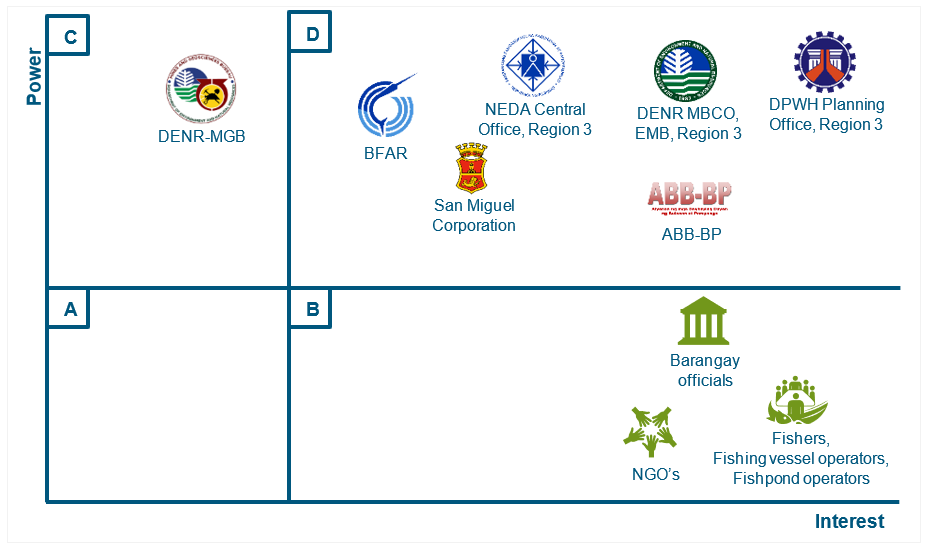Stage 5: Stakeholder Analysis
A power–interest matrix was used to classify stakeholders in terms of the power they hold and the extent to which they are likely to be involved. The level of control of each stakeholder is reflected on the vertical axis, and their level of interest is measured on the horizontal axis. The figure below shows the level of control and welfare of the identified key stakeholders in the North Manila Bay area and the proposed extent of engaging and communicating with them.

Quadrant A. "Low Power, Low Interest (Bystander)."
Found in Quadrant A are stakeholders who have low stakes and low interest, just watching from the sidelines, hence the term "bystanders." They may monitor the project’s progress and wait for the results. Still, beyond that, they do not have heavily invested stakes within the sector and usually have little influence on government policy. These stakeholders require minimal effort (e.g., monitoring) and may be generally informed and involved in low-risk matters.
Quadrant B. "Low Power, High Interest (Advocate)."
NGOs, barangay officials, fishermen, fishpond operators, fishing vessel operators and other residents comprise Quadrant B stakeholders. NGOs refer to local and international NGOs which work with local communities on environmental issues, coastal zone management, livelihood development, resilience, and disaster preparedness. The NGOs are sources of local knowledge and are partners of the local communities on advocacy, project planning, and implementation. They have a high level of interest but have relatively scarce resources and little influence in terms of policy-making.
Barangay officials have a high level of interest as the Project would potentially affect their constituents' livelihood and income levels. Their interest will be to implement nature-based solutions that would enhance disaster risk reduction and uplift the fishermen's' and other coastal residents' well-being.
The fisherfolks and other residents are very much interested in the Project, hopeful of the benefits that nature-based solutions may bring, such as increased fish catch, increased income, reduced disruption in their daily activities, reduced damage to properties, and more time to spend on productive endeavors that generally would have been spent on preparing/reinforcing houses before flooding and cleaning homes after flooding.
NGOs, barangay officials, fisherfolks, and other coastal residents have high stakes but relatively little power. They can thus be important allies and advocates in influencing the more powerful stakeholders. These Quadrant B stakeholders should be kept updated with the findings and progress of the Project and their interest maintained.
Quadrant C. "High Power, Low Interest (Possible Mover)."
Stakeholders in Quadrant C are influential, but their interest in the project is relatively low. They are generally passive, but certain events can stimulate their interest and move them to Quadrant D, especially if their intiatives will be significantly affected by nature-based solutions. These stakeholders should generally be kept informed and likewise monitored as their initiatives can potentially contribute to the flooding problem in the North Manila Bay area.
Quadrant D. "High Power, High Interest (Key Player)."
The stakeholders in Quadrant D are the key players who should be engaged closely and with whom the Project's working relationship should be kept strong. These include ABB-BP, DPWH, NEDA, DENR-MBCO, DENR-EMB, and BFAR. They are both powerful and highly interested in nature-based flood protection strategies. These are entities involved in policy, project identification, development and approval, funding, implementation, operation, and supervision. Government support is critical.
The LGU members of ABB-BP (City of Malolos and towns of Calumpit, Hagonoy, Paombong, Bulacan, and Obando in Bulacan province and towns of Masantol, Macabebe, Lubao, and Sasmuan in Pampanga) represented by their respective mayors have the power to become project implementors and/or co-founders of the Project. Because of the forthcoming May 2022 national and local elections, the Project Team must be viewed as politically neutral. The local chief executives engaged in the Project may not be the same local top executives in July 2022 during project implementation.
San Miguel Corporation is likewise found in Quadrant D since its airport city project is located in Bulakan municipality, an LGU member of the ABB-BP. If Bulakan municipality gets selected as a pilot location for the Project, San Miguel Corporation likewise has the power and the potential to co-opt with the Project.